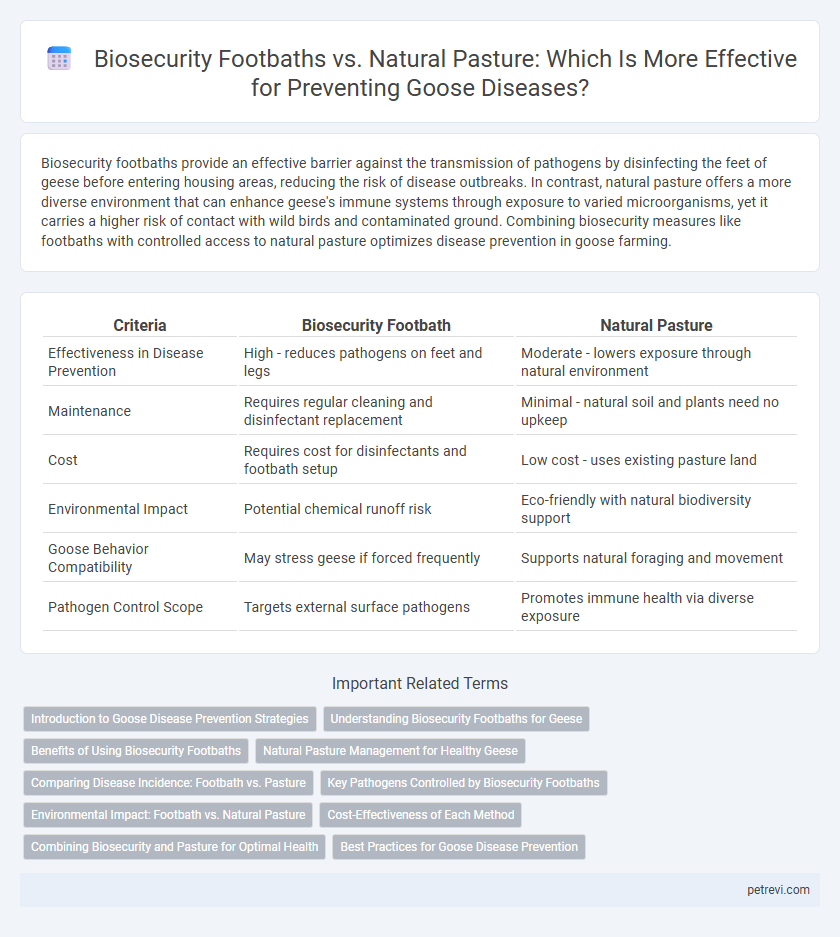Biosecurity footbaths provide an effective barrier against the transmission of pathogens by disinfecting the feet of geese before entering housing areas, reducing the risk of disease outbreaks. In contrast, natural pasture offers a more diverse environment that can enhance geese's immune systems through exposure to varied microorganisms, yet it carries a higher risk of contact with wild birds and contaminated ground. Combining biosecurity measures like footbaths with controlled access to natural pasture optimizes disease prevention in goose farming.
Table of Comparison
| Criteria | Biosecurity Footbath | Natural Pasture |
|---|---|---|
| Effectiveness in Disease Prevention | High - reduces pathogens on feet and legs | Moderate - lowers exposure through natural environment |
| Maintenance | Requires regular cleaning and disinfectant replacement | Minimal - natural soil and plants need no upkeep |
| Cost | Requires cost for disinfectants and footbath setup | Low cost - uses existing pasture land |
| Environmental Impact | Potential chemical runoff risk | Eco-friendly with natural biodiversity support |
| Goose Behavior Compatibility | May stress geese if forced frequently | Supports natural foraging and movement |
| Pathogen Control Scope | Targets external surface pathogens | Promotes immune health via diverse exposure |
Introduction to Goose Disease Prevention Strategies
Biosecurity footbaths serve as a critical barrier, reducing pathogen transmission by sanitizing footwear of farmworkers and visitors to goose facilities, effectively minimizing disease outbreaks. Natural pasture grazing supports goose health by providing a diverse environment that enhances immune function and lowers exposure to concentrated pathogens found in confined spaces. Combining rigorous biosecurity measures with access to natural pastures creates a comprehensive approach to goose disease prevention, optimizing flock welfare and productivity.
Understanding Biosecurity Footbaths for Geese
Biosecurity footbaths serve as a critical barrier against pathogens, reducing the risk of disease transmission in geese by disinfecting feet and legs before they enter clean areas. These footbaths typically contain approved disinfectants such as quaternary ammonium compounds or chlorine-based solutions, which are effective against common avian diseases like avian influenza and botulism. In contrast to natural pastures, where exposure to wild birds and contaminated environments is higher, biosecurity footbaths offer a controlled method to maintain flock health by minimizing contact with infectious agents.
Benefits of Using Biosecurity Footbaths
Biosecurity footbaths significantly reduce the transmission of pathogens by disinfecting footwear and equipment, creating a controlled barrier against infectious agents in goose farming. This method enhances overall flock health by minimizing exposure to harmful bacteria and viruses that are commonly found in natural pastures. Regular use of footbaths supports sustainable disease prevention practices, leading to higher productivity and lower veterinary costs.
Natural Pasture Management for Healthy Geese
Natural pasture management enhances goose health by providing a clean and rich environment that minimizes pathogen exposure and supports natural behaviors. Rotational grazing and proper pasture maintenance reduce the buildup of parasites and harmful bacteria, promoting a resilient immune system. This approach complements biosecurity footbaths by lowering disease risk through sustained environmental hygiene and nutritional benefits.
Comparing Disease Incidence: Footbath vs. Pasture
Using a biosecurity footbath significantly reduces the incidence of common goose diseases such as avian influenza and bacterial infections compared to natural pasture environments. Studies show footbaths decrease pathogen transmission by up to 70%, whereas geese grazing on natural pasture face higher exposure to soil-borne parasites and viral agents. Implementing footbath protocols offers a controlled sanitation barrier that limits disease outbreaks more effectively than relying solely on natural grazing conditions.
Key Pathogens Controlled by Biosecurity Footbaths
Biosecurity footbaths effectively target key pathogens such as Salmonella, Avian Influenza virus, and Escherichia coli, reducing the risk of contamination in goose populations. Natural pasture environments expose geese to diverse microbial flora but lack the concentrated control over specific pathogens that footbaths provide. Implementing footbaths at entry points significantly minimizes cross-contamination and disease transmission in intensive goose farming operations.
Environmental Impact: Footbath vs. Natural Pasture
Biosecurity footbaths effectively reduce pathogen transmission in geese by disinfecting their feet, but often involve chemical use that can impact soil and water quality negatively. Natural pasture promotes healthier ecosystems and diverse microbial environments that support geese immunity while minimizing chemical residues. Choosing natural pasture aligns with sustainable farming practices by reducing environmental contamination and enhancing biodiversity.
Cost-Effectiveness of Each Method
Biosecurity footbaths provide a controlled environment for disinfecting geese, significantly reducing pathogen transmission with moderate initial setup costs and low ongoing maintenance expenses. Natural pasture allows geese to exhibit natural behaviors and immune responses but often incurs higher long-term costs due to increased disease exposure and potential veterinary treatments. Evaluating cost-effectiveness, biosecurity footbaths typically offer more consistent disease prevention outcomes and lower cumulative expenses compared to natural pasture management.
Combining Biosecurity and Pasture for Optimal Health
Combining biosecurity footbaths with natural pasture access enhances goose disease prevention by reducing pathogen exposure while promoting immunity through natural foraging. Biosecurity footbaths effectively eliminate harmful bacteria and viruses on footwear, minimizing contamination risks in housing environments. Integrating these measures supports optimal health by balancing sanitation protocols with the benefits of a parasite-controlled, nutrient-rich pasture habitat.
Best Practices for Goose Disease Prevention
Biosecurity footbaths serve as an effective barrier against infectious agents by disinfecting footwear and preventing the spread of pathogens among goose populations, reducing outbreaks of diseases such as avian influenza and bacterial infections. Natural pasture promotes healthier geese through access to diverse foraging, which strengthens their immune systems and minimizes stress-related susceptibility to illness. Combining strict footbath protocols with rotational grazing on natural pastures optimizes disease prevention by limiting pathogen exposure and supporting overall flock resilience.
Biosecurity Footbath vs Natural Pasture for Goose Disease Prevention Infographic

 petrevi.com
petrevi.com